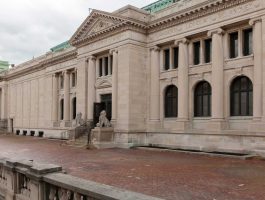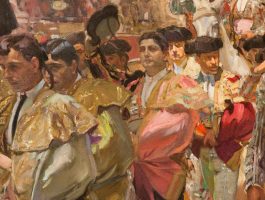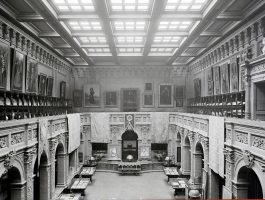The Mezzanine provides a survey of five centuries of Spanish painting from the 16th century up to the early 20th century drawn from masterworks in the collection. Highlights from the 16th century include Portrait of the Duke of Alba (1549) by Antonis Mor, The Holy Family with the Horoscope of Christ (ca. 1562-69) by Luis de Morales, the anonymous portrait of The Family of Philip II of Spain (ca. 1583-85), and a selection of works by Domenikos Theotokopoulos, known as El Greco. From his period in Rome is Pietà (ca. 1575), and from his early years in Toledo are The Holy Family (ca. 1585), and the portrait Miniature of a Man (ca. 1578-80). Representative of El Greco’s mature works are Saint Jerome as a Penitent (ca. 1600), and Saint Luke (ca. 1600-05).
Works by Spain’s greatest painter, Diego Rodríguez de Silva y Velázquez, serve as an introduction to the Spanish Baroque with three portraits that exemplify major periods of his career as court painter to Philip IV. From his early period in Madrid is the portrait of Gaspar de Guzmán, Conde-Duque de Olivares (ca. 1625-26); followed by one of his most intimate works Portrait of a Little Girl (ca. 1638-44), dating from his middle period at court; and from his second visit to Italy is the portrait of Camillo Astalli, Known as Cardinal Pamphili (ca. 1650-51). Paintings featured on the Mezzanine by other 17th-century masters include Saint Lucy (ca. 1630) and Saint Rufina (ca. 1635) by Francisco de Zurbarán; Saint Paul (1632) by Jusepe de Ribera; The Prodigal Son among the Swine (ca. 1656-65) by Bartolomé Esteban Murillo; Via Crucis (1661) by Juan de Valdés Leal; Virgin of the Immaculate Conception (1670) by Juan Carreño de Miranda; and Marie Louise of Orléans, Queen of Spain, Lying in State (1689-90) by Sebastián Muñoz.
The transition from Old Master to modern in the late 18th and early 19th centuries can be seen in the portrait of A Spanish Princess (ca. 1794-95) by Agustín Esteve, and in the portraits of Manuel Lapeña (1799) and Pedro Mocarte (ca. 1805-06) by one of Spain’s most celebrated artists Francisco de Goya y Lucientes. The Romantic portrait of Jean-Auguste-Dominique Ingres (1833) by Federico de Madrazo y Kuntz, contrasted with the scenes of daily life executed in impressionistic brushwork of Arabs Ascending a Hill (ca. 1862-63) and Portico, Church of San Ginés (ca. 1868) by Mariano Fortuny Marsal, are illustrative of the stylistic evolution of painting in Spain in the 19th century. During the closing decades of the century many North American artists made pilgrimages to Spain to study the paintings of Velázquez. One of the most notable was John Singer Sargent, whose travels through Spain in 1879 inspired The Spanish Dance (1879-80) that concludes the selection of works by 19th-century artists.
Exceptional works by modern Spanish masters of the early 20th century begin with Joaquín Sorolla y Bastida and three of his most famous beach scenes, After the Bath (1908), Sea Idyl (1908), and the monumental canvas Beaching the Boat (1903), as well as the magnificent portrait of Louis Comfort Tiffany (1911). Quintessential paintings by the Basque traditionalist artist Ignacio Zuloaga y Zabaleta include Lucien Bréval as Carmen (1908), which the artist acknowledged as one of his best paintings, and the engaging portrait of his fellow Basque Miguel de Unamuno (1926). Representative of Catalan modernism are Calvario at Sagunto (1901) by Santiago Rusiñol, La Roser (1909) by Isidre Nonell, and Girls of Burriana (1910-11) by Hermengildo Anglada-Camarasa. The survey concludes with the expressionistic Fishermen of Castro Urdiales (ca. 1917) by José Gutiérrez Solana, one of the most singular Spanish artists of the 20th century.




